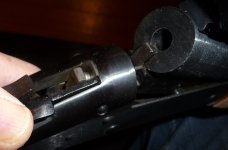- Location
- ON, North of GTA
As title states I am having light strikes on my H&R Handi .223.
I am pretty sure I've done all I can do to get it working and I am just not having any success.
Things I've tried
-New hammer spring from Wolff springs. These are supposed to be extra power springs but wire measures same diameter as original. I ordered a 5 pack of these and have tried a few different ones but no luck.
-Polished firing pin and channel as well as clipped 1.5 coils off of return spring so it won't be fighting hammer spring as much.
-Polished hammer pivot pin
-Took hammer stop down some to get an extra .030" firing pin protrusion
-Tried hammer spur thinking more hammer mass might help but was actually a softer hit, not surprised as velocity has a greater effect on kinetic energy than mass does.
With my .223 barrel on I can get it to fire after 2-5 hits. Have tried some factory ammo and my reloads with Ginex and CCI primers, picked up some Federal primers to try today as they are known to be softer. If those work great, but they won't help issue with shotgun shell.
I have two 12GA barrels and one has a less than perfect headspace so that likely plays some roll. On that barrel I get a very shallow pin prick of a hit.
The other barrel which is headspaced perfectly has same issues. Both have been tried with Federal and Challenger mini shells as well as Federal 2 3/4" target loads as well and some 9mm with barrel insert.
I am beginning to feel if I can't get any progress with this I'll be parting it out as spares parts, stocks and barrels. I have a bunch of H&R stuff and really want to get it working.
Does anyone else have similar issues and were you able to correct them?
I am pretty sure I've done all I can do to get it working and I am just not having any success.
Things I've tried
-New hammer spring from Wolff springs. These are supposed to be extra power springs but wire measures same diameter as original. I ordered a 5 pack of these and have tried a few different ones but no luck.
-Polished firing pin and channel as well as clipped 1.5 coils off of return spring so it won't be fighting hammer spring as much.
-Polished hammer pivot pin
-Took hammer stop down some to get an extra .030" firing pin protrusion
-Tried hammer spur thinking more hammer mass might help but was actually a softer hit, not surprised as velocity has a greater effect on kinetic energy than mass does.
With my .223 barrel on I can get it to fire after 2-5 hits. Have tried some factory ammo and my reloads with Ginex and CCI primers, picked up some Federal primers to try today as they are known to be softer. If those work great, but they won't help issue with shotgun shell.
I have two 12GA barrels and one has a less than perfect headspace so that likely plays some roll. On that barrel I get a very shallow pin prick of a hit.
The other barrel which is headspaced perfectly has same issues. Both have been tried with Federal and Challenger mini shells as well as Federal 2 3/4" target loads as well and some 9mm with barrel insert.
I am beginning to feel if I can't get any progress with this I'll be parting it out as spares parts, stocks and barrels. I have a bunch of H&R stuff and really want to get it working.
Does anyone else have similar issues and were you able to correct them?








































































